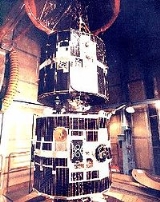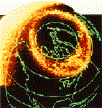
Dynamics Explorer
Encyclopedia
Dynamics Explorer was a NASA
mission, launched on August 3, 1981 and terminated on February 28, 1991. It consisted of two unmanned satellites, DE-1 and DE-2, whose purpose was to investigate the interractions between plasmas in the magnetosphere
and those in the ionosphere
. The two satellites were launched together into polar
coplanar orbits, which allowed them to simultaneously observe the upper and lower parts of the atmosphere.
NASA
The National Aeronautics and Space Administration is the agency of the United States government that is responsible for the nation's civilian space program and for aeronautics and aerospace research...
mission, launched on August 3, 1981 and terminated on February 28, 1991. It consisted of two unmanned satellites, DE-1 and DE-2, whose purpose was to investigate the interractions between plasmas in the magnetosphere
Magnetosphere
A magnetosphere is formed when a stream of charged particles, such as the solar wind, interacts with and is deflected by the intrinsic magnetic field of a planet or similar body. Earth is surrounded by a magnetosphere, as are the other planets with intrinsic magnetic fields: Mercury, Jupiter,...
and those in the ionosphere
Ionosphere
The ionosphere is a part of the upper atmosphere, comprising portions of the mesosphere, thermosphere and exosphere, distinguished because it is ionized by solar radiation. It plays an important part in atmospheric electricity and forms the inner edge of the magnetosphere...
. The two satellites were launched together into polar
Geographical pole
A geographical pole is either of the two points—the north pole and the south pole—on the surface of a rotating planet where the axis of rotation meets the surface of the body...
coplanar orbits, which allowed them to simultaneously observe the upper and lower parts of the atmosphere.
Design
Both spacecraft had a polygonal shape, and were approximately 137 cm in diameter and 115 cm high. Each also had a 200-cm radio antenna and two 6-meter booms which were needed to distance some of the equipment from the main body of the spacecraft. They were stacked on top of each other and launched aboard a Delta 3000 booster rocket. Upon reaching orbit, the two spacecraft departed from the booster and entered separate orbits. Dynamics Explorer 1 was placed into a high altitude elliptical orbit, while DE-2 was put into a lower orbit that was also more circular.Dynamics Explorer 1 Instrumentation
The main instrument aboard Dynamics Explorer 1 was the Plasma Wave Instrument (PWI). This instrument, designed and built by the Plasma Wave Group, measured auroral kilometric radiation, auroral hiss, Z-mode radiation, and narrow band electromagnetic emissions. Additional Instruments aboard the spacecraft included:- The Spin-scan Auroral Imager (SAI)
- The Retarding Ion Mass Spectrometer (RIMS)
- The Energetic Ion Mass Spectrometer (EIMS)
Dynamics Explorer 2 Instrumentation
The Dynamics Explorer 2 carried the following instruments for data collection:- A Retarding Potential Analyzer, which measured the ion flux along the velocity vector of the spacecraft. This data was then used to determine the ion temperature and drift velocity in the spacecraft's area.
- An Ion drift meterIon drift meterAn ion drift meter is a device used to measure the velocity of individual ions in the area of a spacecraft. This information can then be used to calculate the ion drift in the space surrounding the instrument as well as the strength of any electric field present, provided that the magnetic field...
, which measured the ambient ion drift. - A MagnetometerMagnetometerA magnetometer is a measuring instrument used to measure the strength or direction of a magnetic field either produced in the laboratory or existing in nature...
- A Vector Electric Field Instrument

- A Neutral Atmosphere Composition Spectrometer
- A Wind and Temperature Spectrometer
- A Fabry–Pérot interferometer
- A Low-Altitude Plasma Instrument
- A Langmuir probeLangmuir probeA Langmuir probe is a device named after Nobel Prize winning physicist Irving Langmuir, used to determine the electron temperature, electron density, and electric potential of a plasma. It works by inserting one or more electrodes into a plasma, with a constant or time-varying electric potential...

